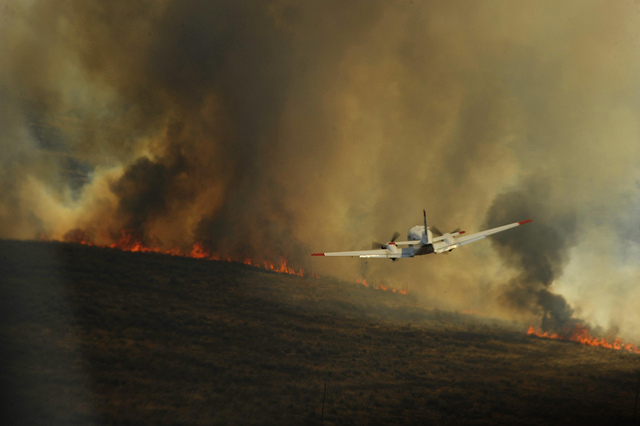
While the Mississippi River rises in historic floods a few hundred miles to the east. extreme heat and drought continue to afflict Texas with wildfires that so far have seared a thousand square miles. And there's more to come. (U.S. Air Force Photo/Staff Sgt. Eric Harris)
While the central and southern states are disappearing under floodwaters of historic immensity, a searing, lengthening drought is crisping the prospects of the American West and Southwest. Two recent major reports — one of them from the Department of the Interior — sounded strident alarm bells about the coming Big Thirst, while the loudest voices in Congress continue to decry climate change as a “hoax.”
[Note to Congress: when people are drowning, or dying of thirst, or starving, your ongoing debate about “sound” science and “natural cycles” and “Climate-Gate” looks more and more like what it is: utter lunacy, and a near-criminal failure to protect and defend the people you represent.]
According to both the Stockholm Environment Institute (The Last Drop: Climate Change and the Southwest Water Crisis) and the US Interior Department’s Bureau of Reclamation (Reclamation Climate Change and Water 2011), the already serious drought affecting the Southwest and West is going to get much worse over the next decades. The Bureau of Reclamation finds that water flow in some of the American West’s biggest river basins — including the Rio Grande and the Colorado — will drop by up to 20 percent this century. The Stockholm Institute concludes that “water demand in the Southwest will outstrip water supply in the near future.”
Both reports stress that climate change is going to make a bad situation worse. Before the spinmeisters derail the discussion into a shoutfest about whether most of the world’s scientists are participating in a pointless hoax, it would be well to focus on the fact that without taking climate change into consideration, the situation is bad. And will get worse.
The reason, as stated in the opening sentence of the Stockholm report: “At present, without climate change, the Southwest is relying on the unsustainable withdrawal of groundwater reserves to meet today’s demand; those reserves will be drained over the next century as population and incomes grow.” So perhaps we could forgo the argument about why it’s happening and focus on what’s happening?
The real basis of the problem is that since the 1980s the American West has been using more water every year than rain and snow can provide. The relentlessly increasing demands of industrial agriculture and urban sprawl have been met by pulling up groundwater, whose replacement rate is a fraction of current withdrawal rates.
The irony is that water is not “consumed” — the amount of water present on earth does not change and will not change. But it can be used, and when used can be changed in state from liquid to vapor, moved from one region to another, or tainted. It is not the amount of water that is critical to survival, it is the availability of water where and when it is needed.
Interior Secretary Ken Salazar, a former US Senator from Colorado, does not share the “don’t-worry-be-happy” mantra of his former elected colleagues. “Alarm bells” are sounding about the West’s water supplies, he says, and he feels for an “urgency of planning” to deal with the issue.
Indeed. The report from his agency forecasts, for the Western states during this century:
- a temperature increase of 5-7 degrees Fahrenheit;
- a precipitation increase over the northwestern and north-central portions of the western United States and a decrease over the southwestern and south-central areas;
- a decrease for almost all of the April 1st snowpack, a standard benchmark measurement used to project river basin runoff; and
- an 8 to 20 percent decrease in average annual stream flow in several river basins, including the Colorado, the Rio Grande, and the San Joaquin.
Avoiding really grave consequences, according to the Stockholm report, will require severe restrictions on agricultural and/or residential uses of water. Which is going to be a little hard to do when one prerequisite for holding public office these days is a denial of the theory of evolution, and any other scientific finding that does not square with tea-party rhetoric. (Next qualifying question for presidential candidates: “Do you believe in arithmetic? Yes? Out with you.”)
It also bears mentioning that Texas continues to burn. Although the story has slipped into the “old news” category and off the national radar screen, the same high heat and winds that have brought the state one of the worst wildfire seasons in its history continue today to spark and spread devastating and deadly fires.
Alarm bells are ringing everywhere in the country, whether they signal rising water or deadly drought. But denial, as they say, is not just a river in Egypt, and denial is well above flood stage in America.
[For updates on this and other stories, check out the Editor’s Log.]